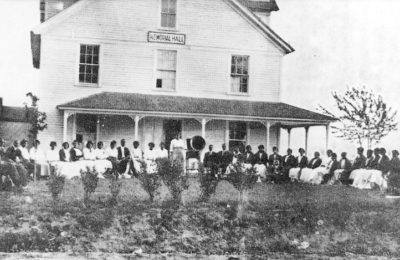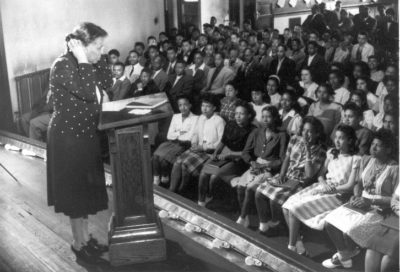Repair work at the Charlotte Hawkins Brown Museum
16 May 2019 – Sonya Laney
African American history, NCPH 2019 Awards, museums, education, race, community engagement, 2019 annual meeting

Charlotte Hawkins Brown, 1905. Photo credit: Charlotte Hawkins Brown Museum
Editor’s Note: This is the second in a series of reflective posts written by winners of awards given out at the NCPH 2019 annual meeting in Hartford, Connecticut. Sonya Laney received the New Professional award.
In 1902, Charlotte Hawkins Brown took the train from her home in Cambridge, Massachusetts to the rural town of Sedalia, North Carolina. What would compel a barely-nineteen-year-old African American woman to move from a relatively comfortable life in a progressive northeastern city to the deeply segregated Jim Crow South? Pulled by providence, Brown felt that the chance to teach at an American Missionary Association (AMA) school was God calling her home to her birth state of North Carolina. After just a few months of teaching at the AMA sponsored Bethany Church school, and with the urging of community members, Brown founded the Palmer Memorial Institute.
Palmer Memorial Institute, named after Brown’s friend and mentor Alice Freeman Palmer, would go on to be one of the first elite coeducational Black preparatory boarding schools in the nation. In the 69 years that Palmer was open, more than one thousand students graduated from the institution. These students would go on to be politicians, artists, educators, military officers, and lawyers and serve in many other notable professions. In the 1960s the school surveyed current students and found that more than 90% would go on to college and higher education, a rate that greatly exceeded the modern pursuance of post-secondary education.[1]
The theme of this year’s NCPH annual meeting, Repair Work, provided a befitting lens through which to view the Brown’s story and the mission of the Charlotte Hawkins Brown Museum that honors her. Dr. Brown was persistent in the pursuit of her own “repair work”; improving race relations in a segregated state, securing the rights of women, and expanding educational opportunities for African American students in the twentieth century. Her repair work took shape in Palmer Memorial Institute and flowed throughout the civic work that she completed over her lifetime. As staff at the only North Carolina State Historic Site devoted to an African American woman, we do plenty of repair work of our own. We are working to repair our story, publicize the narrative of Dr. Brown, and strengthen our relationship with the community.

One of the earliest buildings on Campus, Memorial Hall, as photographed with students in the 1910s. Photo credit: Charlotte Hawkins Brown Museum
Of course, there are plenty of physical repairs to make as well. With 11 buildings, 40 acres, and a small but dedicated staff of four, we stay busy with upkeep and programming. However, there is plenty of repair work we do that does not yield such tangible results. This means tackling big issues, such as contextualizing racial justice and introducing the story of Dr. Charlotte Hawkins Brown to visitors for the first time. It also means smaller issues, such as repairing staff-community relationships since many of our visitors and community members are still getting to know us.
Our site has undergone a complete staff turnover in the last two years, meaning that we have spent considerable time repairing relationships with community members, Palmer alumni, and board members. How do we repair the trust of our stakeholders and provide programming and events that are not only relevant but valuable? We prioritize a shared-authority approach with our community and try to emphasize that we are not merely a museum and historic site but also a community center.
When I started my position as education coordinator at the Charlotte Hawkins Brown Museum, I was apprehensive. How do I explain a topic as complicated as segregation, a vital piece of our story, to second graders on a field trip? How do I explain to children why a school like Palmer was necessary? How do I adequately convey that although Palmer was a necessity due to a segregated society, it primarily admitted (in the words of Dr. Brown) “upper class, intelligent Negroes”? The solution, thus far, has been to have our field-trip students help with the repair work we are doing. I have found that kids, regardless of age, are much more resilient than we give them credit for. Generally, I start a field trip by asking students a question: what is segregation? Sometimes, kids get it right off the bat. Oftentimes, they need a little coaxing. Often, I end up asking what word “segregation” sounds like. Immediately, little arms shoot up in the air and a student or two will respond “…separation?” Involving kids in the explanation of a difficult history is usually a surefire way to help them understand it.
Although Palmer opened in 1902 with an agricultural and technical curriculum popular with its wealthy white donors, Dr. Brown shifted the curriculum to college prep, etiquette, and the arts thirty years after the school’s founding, targeting the children of a rising Black elite. Many current visitors to the site request programming that teaches etiquette rules, such as learning how to set a formal table, how to politely answer the phone, and dressing in a respectable manner. We are working on repairing the narrative that visitors take away about the relationship between Charlotte Hawkins Brown and etiquette. Instead of merely explaining which fork to use during a formal meal, we encourage visitors to think critically about why etiquette was important for Palmer students. Why might Dr. Brown have emphasized being comfortable and prepared in any social situation for young Black students in the 1940s and ’50s? Having an education based on an etiquette-centered curriculum helped students transcend some of the racial stereotypes and limitations that society placed upon them. Dr. Brown taught her students not only to be respectful but to demand respect from others.

Dr. Brown speaking to students in the campus chapel in 1947. Photo credit: Charlotte Hawkins Brown Museum
Nearly all the topics that we interpret at the museum remain relevant today. Along with running Palmer, Dr. Brown was an accomplished civic leader, suffragist, and clubwoman. During her extensive civic and social justice work, Dr. Brown worked toward women’s rights, racial equality, rights for the poor, immigrant rights, and workers’ rights. Visitors often find themselves grappling with the same questions and issues that Dr. Brown grappled with. I like to think that visitors and I can do our own repair work and reconcile contemporary issues by digging into history.
I’m not sure our repair work at the Charlotte Hawkins Brown Museum will ever be done. Frankly, I’m not sure that any museum will ever be, or should be, done with repair work. If we are not constantly reworking, reimagining, and repairing, are we doing our due diligence as museum professionals? As for the staff at the museum, we will continue working with our small but mighty community and the Palmer alumni, many of whom still frequently visit their old stomping grounds, to repair the notion that Charlotte Hawkins Brown and Palmer Memorial Institute have been lost to the confines of history. As a staff made entirely of emerging museum professionals, we’ll work to repair the gaps in our own knowledge. We’ll continue to seek out new opportunities, new experiences, and new ways to interpret this unique and powerful narrative.
~ Sonya Laney is education coordinator at the Charlotte Hawkins Brown Museum. She is a recent graduate of the University of North Carolina at Greensboro where she received her Masters in History with a concentration in Museum Studies.
[1] United States Department of Labor, Bureau of Labor Statistics. College Enrollment and Work Activity of Recent High School and College Graduates Summary, April 2018. https://www.bls.gov/news.release/hsgec.nr0.htm.



